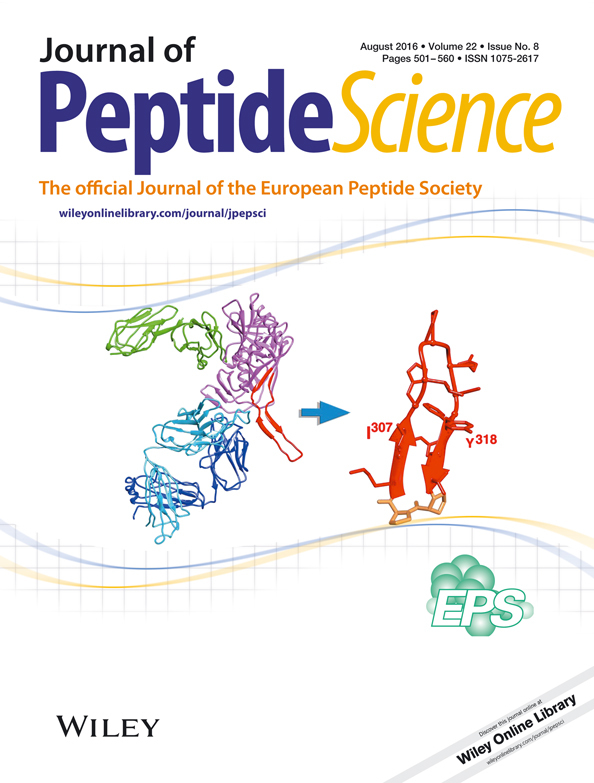On the synthesis of cyclodextrin–peptide conjugates by the Huisgen reaction
Corresponding Author
Rémy Lartia
Université Grenoble-Alpes, Département de Chimie Moléculaire, 570 rue de la chimie, 38041 Grenoble, France
Correspondence to: Rémy Lartia, Université Grenoble-Alpes, Département de Chimie Moléculaire, 570 rue de la chimie, 38041 Grenoble, France. E-mail: [email protected]Search for more papers by this authorChristopher K. Jankowski
Département de Chimie et Biochimie, Université de Moncton, Moncton, NB, E1A 3E9 Canada
Search for more papers by this authorSébastien Arseneau
Département de Chimie et Biochimie, Université de Moncton, Moncton, NB, E1A 3E9 Canada
Search for more papers by this authorCorresponding Author
Rémy Lartia
Université Grenoble-Alpes, Département de Chimie Moléculaire, 570 rue de la chimie, 38041 Grenoble, France
Correspondence to: Rémy Lartia, Université Grenoble-Alpes, Département de Chimie Moléculaire, 570 rue de la chimie, 38041 Grenoble, France. E-mail: [email protected]Search for more papers by this authorChristopher K. Jankowski
Département de Chimie et Biochimie, Université de Moncton, Moncton, NB, E1A 3E9 Canada
Search for more papers by this authorSébastien Arseneau
Département de Chimie et Biochimie, Université de Moncton, Moncton, NB, E1A 3E9 Canada
Search for more papers by this authorAbstract
A,D-substituted cyclodextrin (CDX) substituted on their primary rim side are ideal scaffolds for the macromolecular assembly and formation of templated structures. Their substitution can be achieved through various reactions. However, the use of the well-known Huisgen reaction in this context is under-reported. We present here results of the synthesis of model conjugates formed between CDX and representative peptides by click chemistry. Notably, bis-conjugation of peptides onto a unique scaffold promotes α-helix formation. Copyright © 2016 European Peptide Society and John Wiley & Sons, Ltd.
Supporting Information
Figure S1. ESI-MS spectra of compound 3
Figure S2. ESI-MS spectra of compound 4
Figure S3. ESI-MS spectra of compound 5
Figure S4. ESI-MS spectra of compound 6
Figure S5. ESI-MS spectra of compound 7
Figure S6. ESI-MS spectra of compound 8
Figure S7. ESI-MS spectra of compound 9b
Figure S8. ESI-MS spectra of compound 10
Figure S9. ESI-MS spectra of compound 11
| Filename | Description |
|---|---|
| psc2899-sup-0001-Supplementary.docxWord 2007 document , 175.3 KB | Supporting info item |
Please note: The publisher is not responsible for the content or functionality of any supporting information supplied by the authors. Any queries (other than missing content) should be directed to the corresponding author for the article.
References
- 1DeGrado WF, Kaiser ET. Polymer-bound oxime esters as supports for solid-phase peptide synthesis. The preparation of protected peptide fragments. J. Org. Chem. 1980; 45: 1295–1300. DOI: 10.1021/jo01295a026.
- 2Regan L, DeGrado W. Characterization of a helical protein designed from first principles. Science 1988; 241: 976–978. DOI: 10.1126/science.3043666.
- 3Tuchscherer G, Mutter M. Templates in protein de novo design. J. Biotechnol. 1995; 41: 197–210. DOI: 10.1016/0168-1656(95)00010-N.
- 4Causton AS, Sherman JC. A comparison of three- and four-helix bundle TASP molecules. J. Pept. Sci. 2002; 8: 275–282. DOI: 10.1002/psc.388.
- 5Jankowski CK, Foucher S, Fermandjian S, Maroun RG. Study of peptide oligomer derived from HIV-1 integrase molecular modelling. J. Mol. Struct. (THEOCHEM) 2005; 757: 125–136. DOI: 10.1016/j.theochem.2005.09.020.
- 6Jankowski, C.K., Martel, J.-L., Fermandjian, S., Maroun, R.G. Study of potential HIV-1 inhibition. Glutaric dialdehyde adducts. J. Mol. Struct. (THEOCHEM). 2005; 731: 83–87. DOI: 10.1016/j.theochem.2005.06.044
- 7Maroun RG, Zargarian L, Stocklin R, Troalen F, Jankowski CK, Fermandjian S. A structural study of model peptides derived from HIV-1 integrase central domain. Rapid Commun. Mass Spectrom. 2005; 19: 2539–2548. DOI: 10.1002/rcm.2093.
- 8Hocquelet C, Blu J, Jankowski CK, Arseneau S, Buisson D, Mauclaire L. Synthesis of calixarene–cyclodextrin coupling products. Tetrahedron 2006; 62: 11963–11971. DOI: 10.1016/j.tet.2006.09.089.
- 9Hanessian S, Hocquelet C, Jankowski C. Synthesis of aminocyclodextrin carboxylic acids. Synlett 2008; 715–719. DOI: 10.1055/s-2008-1042803.
- 10Bertolla C, Rolin S, Evrard B, Pochet L, Masereel B. Synthesis and pharmacological evaluation of a new targeted drug carrier system: beta-cyclodextrin coupled to oxytocin. Bioorg. Med. Chem. Lett. 2008; 18: 1855–1858. DOI: 10.1016/j.bmcl.2008.02.017.
- 11White RJ, Plieger PG, Harding DR. Synthesis of bifunctional peptide derivatives based on a β-cyclodextrin core with drug delivery potential. Tetrahedron Lett. 2010; 51: 800–803. DOI: 10.1016/j.tetlet.2009.11.118.
- 12Schaschke N, Assfalg-Machleidt I, Machleidt W, Lassleben T, Sommerho CP, Moroder L. Cyclodextrin/epoxysuccinyl peptide conjugates: a new drug targeting system for tumor cells. Bioorg. Med. Chem. Lett. 2000; 10: 677–680. DOI: 10.1016/S0960-894X(00)00078-0.
- 13Schaschke N, Fiori S, Weyher E, Escrieut C, Fourmy D, Mueller G, Moroder L. Cyclodextrin as carrier of peptide hormones. Conformational and biological properties of α-cyclodextrin/gastrin constructs. J. Am. Chem. Soc. 1998; 120: 7030–7038. DOI: 10.1021/ja973852g.
- 14Hong, V., Presolski, S.I., Ma, C., Finn, M.G. Analysis and optimization of copper-catalyzed azide-alkyne cycloaddition for bioconjugation. Angew. Chem. Int. Ed. 2009; 48: 9879–9883. DOI: 10.1002/anie.200905087
- 15Brady B, Lynam N, O'Sullivan T, Ahern C, Darcy R, Shea KM, Danheiser RL. 6A-O-p-toluenesulphonyl-β-cyclodextrin. Org. Synth. 2000; 77: 220 10.15227/orgsyn.077.0220.
- 16Melton LD, Slessor KN. Synthesis of monosubstituted cyclohexaamyloses. Carbohydr. Res. 1971; 18: 29–37. DOI: 10.1016/S0008-6215(00)80256-6.
- 17Jankowski CK, Arseneau S, Blu J, Mauclaire L, Aychet N. On the synthesis of new amphiphilic entities by the succinic coupling of β-cyclodextrins to calixarenes. Can. J. Chem. 2005; 83: 493–498. DOI: 10.1139/V05-070.
- 18Lecourt T, Herault A, Pearce AJ, Sollogoub M, Sinaÿ P. Triisobutylaluminium and diisobutylaluminium hydride as molecular scalpels: the regioselective stripping of perbenzylated sugars and cyclodextrins. Chem. Eur. J. 2004; 10: 2960–2971. DOI: 10.1002/chem.200305683.
- 19Kitagishi H, Chai F, Negi S, Sugiura Y, Kano K. Supramolecular intracellular delivery of an anionic porphyrin by octaarginine-conjugated per-O-methyl-β-cyclodextrin. Chem. Commun. 2015; 51: 2421–2424. DOI: 10.1039/c4cc09042j.
- 20Luo P, Baldwin RL. Mechanism of helix induction by trifluoroethanol: a framework for extrapolating the helix-forming properties of peptides from trifluoroethanol/water mixtures back to water. Biochemistry 1997; 36: 8413–8421. DOI: 10.1021/bi9707133.
- 21Jankowska A, Jankowski CK, Chiasson JB. On chloralose–cyclodextrin complexes by ESI-mass spectrometry. J. Incl. Phenom. Macrocycl. Chem. 2005; 52: 213–221. DOI: 10.1007/s10847-004-7239-7.
- 22Jankowski CK, Pelletier A, Aychet N, Hocquelet C, Lacour JL, Bresson C. Laser-induced, one-step synthesis of cyclodextrin carboxylic acids and their esters. Indian J. Chem. 2014; 53B: 1611–1614.




